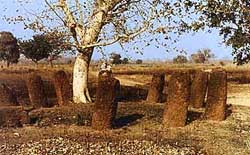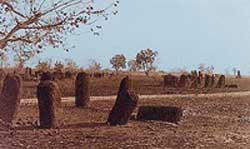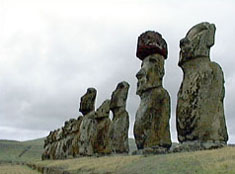

STONE AGE
BUILDING INDEX
STONE AGE
BUILDING
STANDING
STONES
NEWGRANGE
STONEHENGE
MALTA'S MEGALITHIC MARVELS
SKARA BRAE
HUNEBEDDEN
Stone Circles
Erich van Däniken states that the knowledge of stone building came from spacetravellers. I don't know about that, but it certainly an interesting point of view. In his book "Die Steinzeit war ganz anders" (The stone age was competely different) he gives a list of examples of stone circles all over the world:
- Wasu in Gambia, Africa
- Brahmagiri, south of the rivers Narmada and Godavari in India, Asia
- Nioro du Rip, in the province Casamance in Senegal, Africa
- Sillustani at Titicaca Lake in Peru, South America
- Ain es-Zerka in the east of Jordan, Middle East
- South of the Emu Dessert in Australia
- The southern main island of Japan and on the island Hokaido
- The island of Naue, belonging to the Tongareva Islands
- Several stone circles, ("medicine wheels"), in both the USA and Canada, North America
- Different sizes of stone circles in the dessert of Libia, Northern Africa
- Wesiory in the north of Poland, Eastern Europe
- Terebinthe between Tiberias and Safed in Israel, Middle East
- Znamenka in Minusinker in the former Sowjet Union
- Ke'te-kesu, north of Makale on the island of Sulawesi, Indonesia
- A small stone circle of 72 meters, on the border of Switzerland and Italy, Europe (at an altitude of 2188 meters!)


And not only circles of stone, all kinds of forms are made of huge lumbs of stone: singly erected menhirs, grave tombs as dolmens and mounts, stone lines...
The sites mentioned above are just a fraction of all the megalithic sites there are on Earth. The complete list is over 40 pages long. It can be stated that stone circles and other megalithic buildings are not a regional (European) fenomenon as well as that most of these buildings are connected to mystical of holy legends. Holy, as the Indians regard their 'Veda' as a holy scripture. But in the well known book, the bible, in the book of Josua (4:8,9), we find:
"So the Israelites did as Joshua commanded them. They took twelve stones from the middle of the Jordan, according to the number of the tribes of the Israelites, as the LORD had told Joshua; and they carried them over with them to their camp, where they put them down. Joshua set up the twelve stones that had been in the middle of the Jordan at the spot where the priests who carried the ark of the covenant had stood. And they are there to this day."
It would be interesting to know whether those 12 stones still stand on that place. So if you do know, please mail me!
 Easter Island
Easter Island
Absolutely splendid it must be: Easter Island with its stone giants. On average, they are appr. 4 meters high and weigh 14 tons: human male heads-on-torsos carved from rough hardened volcanic ash. The islanders call them "moai," and they have puzzled every scolar you can think of in this line of science. The first Europeans to see them were explorers under the lead of the Dutchman Jan Roggeveen in 1722.
Why the early inhabitants of Easter Island undertook this huge effort is unknown, as at most megalithic sites still a mystery.
Korea
At Taegu in Korea was erected in the bronze age. The information board says:
"This menhir is a typical example of the megalithic culture in the Bronze Age. It was probably used as a boundary marker or as an object of worship. Being one of the largest menhirs in Korea, it is 4,5m high and 2m around. The Artifacts were found while clearing the area east of this menhir (plain coarse pottery and stone implements) support the theory that it dates from the Bronze Age."
This menhir is is located on a hill at Changpyongri (a.k.a. Shindong) near Taegu in Korea. The stone is called 'Shindong Eepsok', 'Eepsok' or 'Sondol', all meaning 'standing stone' in Korean.
NEWGRANGE STONEHENGE MALTA'S MEGALITHIC MARVELS SKARA BRAE